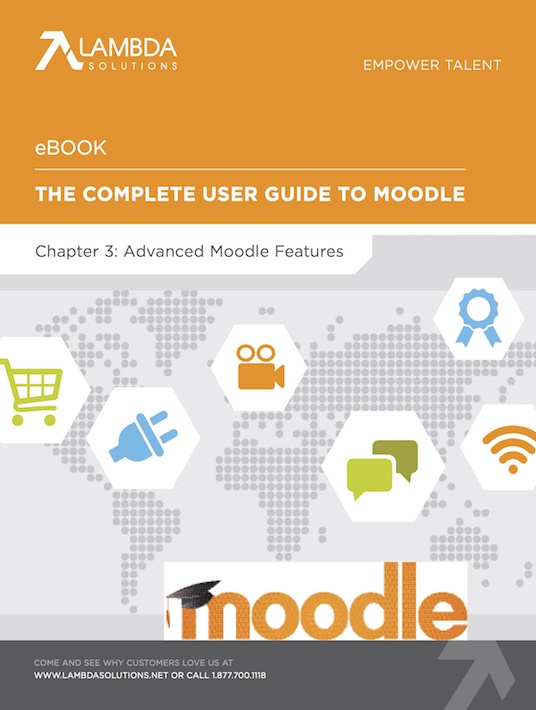Exploring The Extended Features Of Moodle
There’s only one way to make the most of Moodle Learning Management System: by learning how to utilize its extended features. Here, we’ll explore the Moodle multitenancy function, how to enroll cohorts, and some very useful Moodle integrations.

Multitenancy
Multitenancy in Moodle is made possible with the use of Front-page settings and Course Categories. This can be done by configuring the “Front page items when logged in” settings to Enrolled Courses. With regard to branding courses to specific departments or business units, the Course Categories can be named after the department and subcategories can be labeled as Course Topics. Each Category and Subcategory can then be themed separately from the Corporate/ Organizational theme. Roles and capabilities can be assigned to specific categories to allow access to edit courses. Additionally, this can be done by inheritance to the Subcategories and courses.
Enrolling Cohorts
Cohorts are site-wide, or category-wide groups, that can be created by site administrators, and any other users with the relevant permissions. The benefit of using cohorts is you can perform bulk actions for everyone grouped in a cohort – for example, you can enroll an entire cohort into a class. To enroll users by cohorts, you will need to add the Cohort-Syn Enrollment plugin as an enrollment method for the course. As well, the Moodle administrator will need to enable the CohortSyn enrollment plugin site-wide.
Teachers can add cohorts to courses by default, but Moodle managers or admin can hide certain cohorts from teachers by unchecking the ‘Visible’ box in the Cohort settings or by clicking the icon of the eye on the Cohorts screen.
Integrations
Google Apps
This is a new integration between Moodle and Google, allowing you to benefit from the two platforms working seamlessly together.
You will need to centralize the authentication process. You can choose whether you want to login using Google Apps credentials, Moodle credentials, or an existing identity provider (if your institution has a centralized directory).
If you decide to use your Moodle credentials for login, you can implement a Single Sign On (SSO) solution to preserve the session between systems and avoid any direct connections to database. If you use your Google credentials, you can login through an OAuth2 sign-in method. If you choose to use your existing identity provider, you can configure an SSO solution to allow Moodle and Google access through the same credentials, while keeping the session between them running. It’s a simple integration, as Moodle users are automatically created in Google Apps (Google Docs, Calendar, and Gmail). On the Google side of things, there is a Google Widget that will generate a link to Moodle in your Google account.
With the Google Apps integration, you have a couple of configuration options that are not automatically included and will need to be installed.
- You can have a Google Apps menu block displayed on the Moodle Front Page that will show you the links to your various apps (Start Page, Docs, Calendar, Gmail).
- You can display a block specifically for Gmail that will display new messages on your Moodle Front Page.
There are also a few plugin options for specific Google App integrations:
- A Google Drive repository plugin that will pull your files from Google Drive, and into your Moodle.
- A Google Drive portfolio plugin that will push files from your computer into your Google Drive, and then from your Google Drive into Moodle.
Customer Relationship Management System Integrations
Customer Relationship Management (CRM) Systems provide deep value for Sales teams and organizations at large due to the capacity to track, automate, and organize interactions with customers. Organizations who use Moodle for partner, client, channel, or sales training began to see the benefit of having learning information synced with Salesforce. As such a number of integrations have been developed.
- SugarCRM
SugarCRM can be integrated through CourseCRM, a custom implementation of SugarCRM. Integrating directly with Moodle and your eCommerce store: lead, contact, sales and learner activity data is synced into SugarCRM to provide extensive reporting and analytic data. - Salesforce Integration with EnlightenCRM
The challenges that organizations delivering online training encounter have to do with managing their learners. These include issues like scalability, cost, accessibility, and integration with a CRM system. EnlightenCRM integrates Totara and Moodle LMS with salesforce. With this integration tool, you can collect all Moodle and Totara registrations in salesforce, and manage them in that system. The integrated platform also delivers automation and enhanced reporting, and it provides training content to customers, partners, and employees that is mobile-friendly. - InfusionSoft
InfusionSoft, a CRM designed for small businesses, can also be integrated with Moodle through custom developed integrations.
If you want to learn more about the extended features of Moodle, download the eBook The Complete User Guide To Moodle Chapter 3.






